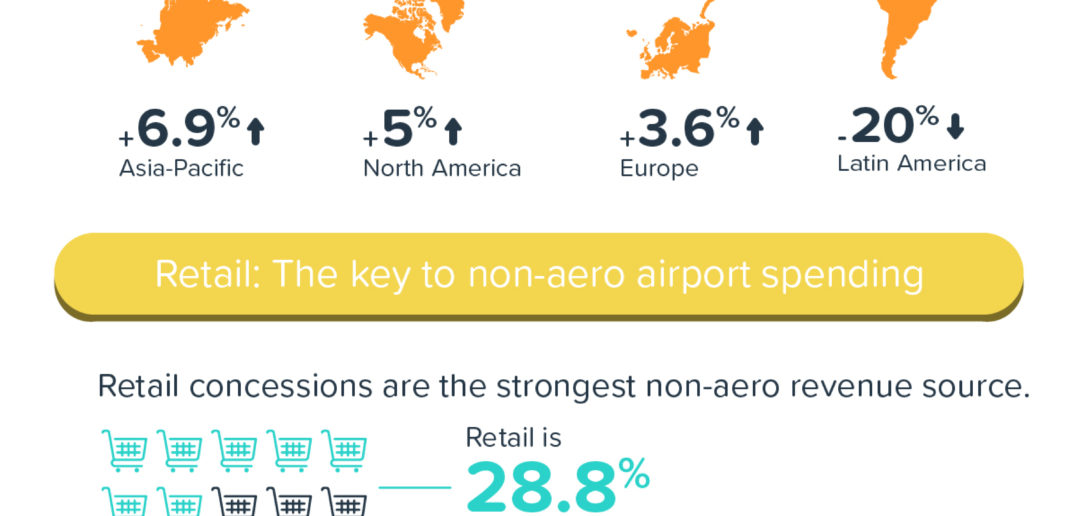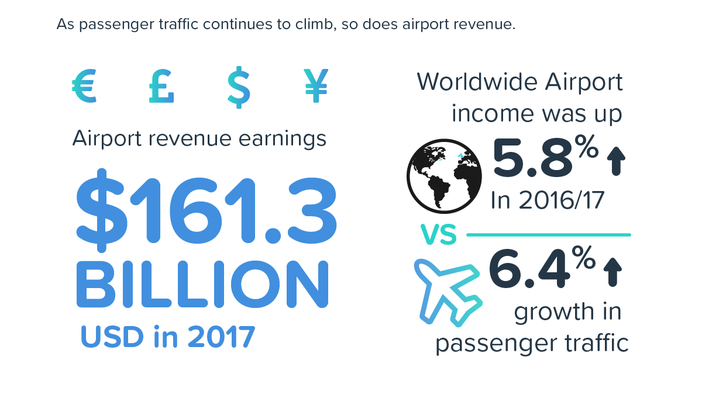Airport revenues continue to trend upward as global passenger traffic reaches record levels, according to the ACI 2018 Airport Economics Report. Perry Graham, director of business development at Concessionaire Analyzer+ – a division of Veovo – examines where the real growth potential lies for airport operators.
Recently, a report by the Airports Council International (ACI) found that industry revenues rose by 5.8% to US$1.61bn (£1.25bn) in the financial year 2016. Increased competition, growing passenger numbers and an upsurge in business confidence have continued to drive investments and growth in airport infrastructure and services, as operators try to keep pace with demand.
This encouraging growth, however, masks a trend that is somewhat unsettling – overall revenue per passenger is flattening out and, in some cases, shrinking. With low-cost carriers driving much of the traffic growth, airports are increasingly competing to attract these carriers with aggressive incentives, making it difficult to grow aeronautical revenue. As a result, a growing number of airports are turning toward the next-largest airport revenue stream to fund growth – non-aeronautical opportunities.
Non-aeronautical revenue – an under-valued potential
With several years of stellar growth under its belt, commercial revenue has always been the bright star for airport income. While growth has tapered recently, opportunities are still plentiful – and many airports are bucking the trend by investing in innovative facilities and services in airport parking, retail, and food and beverage.
Vehicle parking and rental income is currently the primary source of non-aeronautical income for many airports, particularly in North America, where it represents over 58% of income. However, the trend toward off-airport hire, ridesharing and alternative transportation is threatening this vital income source. As a result, many airports are looking to create new multimodal transportation centers and are exploring new transportation-related revenue-generating models.
For example, San Diego Innovation Labs is testing five new parking concepts, including new booking systems, valet parking and a peer-to-peer carsharing platform, and other airports are investing in electric vehicle chargers, assisted parking and dynamic parking fees.
Revamping retail
Globally, retail is the strongest performer in non-aeronautical revenue, contributing 28% of all non-aeronautical income; notably, in the Middle East, it accounts for 56%. However, retail is not immune to disruption.
Global airport retail income declined 3% between 2013 and 2017; meanwhile, in Europe, the shift to online retail caused airport retail incomes to drop by 6% in 2016 compared to 2010.
Other airport retail challenges include a lack of perceived value or differentiation of airport-based stores, as well as longer security and immigration queues cutting into shopping time.
To tackle these issues and to boost retail spending, many airports are turning to data analysis to understand passenger flow and behavior.

Making every minute count
For airports, ensuring passengers enjoy a smooth transit through the airport is vital: spend increases by 2.5% for every minute a customer is in a retail area and not stuck in a queue.
For example, after investing in sensor-based queue management and forecasting analytics, Helsinki Airport (Finavia) successfully reduced queue times to under 15 minutes, thereby boosting non-aeronautical spend by 12.3%.
A better understanding of passenger profiles also enables airports to tailor store experiences and offers, which is what Sydney Airport has done. By reducing its reliance on duty-free sales, and instead investing in speciality and luxury stores targeting the growing visitor base from Asia, the airport increased its retail revenue by 12.7% in 2017.
In addition, passengers are increasingly shopping online so progressive airport operations need to follow suit, offering passengers the opportunity to plan their airport shopping and eating experiences. For example, for every 100,000 visitors to Heathrow Airport’s e-commerce platform, physical retail sales increase by €750,000 (US$852,000).
Tapping into food and beverage
Food and beverage is the rising star of non-aeronautical revenue. Although this currently makes up only 5% of global sales, it is the fastest-growing income category with an 11.2% growth rate.
For Dublin Airport, home of the world’s largest low-cost airline Ryanair, food and beverage is its leading category, generating €87m (US$98.8m) in revenue in 2016 – 20% higher than the airport’s retail income.
With only 59% of passengers buying food and drink in airports, it is increasingly important for operators to offer maximum choice and convenience.
In February 2018, Schiphol airport launched gate-based food deliveries, with Deliveroo delivering food to airport gates within 15 minutes of the order being placed. Similarly, Newark Liberty International Airport has launched a service called AtYourGate, allowing passengers to order refreshments for delivery to their gate before departure.
Data-driven insight will drive commercial innovation
Airport retailers and service operators offer the greatest opportunity for airports to
boost profit. However, the challenge is not only capturing non-aeronautical data but also being able to understand and act upon it. What airports therefore need is a deeper understanding of how passengers spend money, and where the greatest returns on investment lie.
Automation and predictive analytics help airports gain insight into sales, trends and property data to make better commercial planning and operational decisions, as well as streamline concession management.
Airports that can analyze spend along with demographic profiling, flight schedules and passenger flow can go further still – refining products, services, resourcing and advertising to match the time of day, passenger type and overall propensity to purchase.
With innovation in airport commercial revenue growth firmly rooted in data, it’s time to kick-start the revenue revival.
About the author
Perry Graham is director of business development at Concessionaire Analyzer+ (CA+) – a division of Veovo. A civil engineering graduate from the University of Toronto, Graham spent most of his career in consultative solution selling in information technology. Over the past five years, he has become involved in the commercial side of airports, focusing on the management and improvement of non-aeronautical revenues. He joined CA+ (acquired by Veovo in 2017) and now heads up its global sales division.


